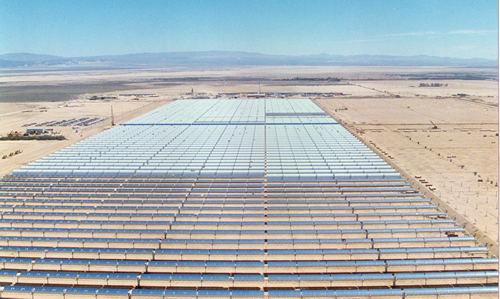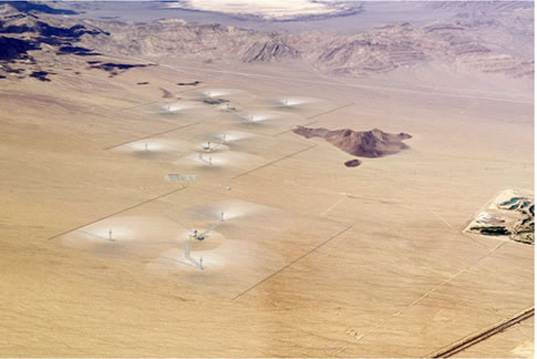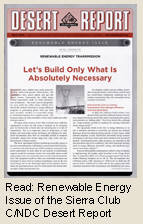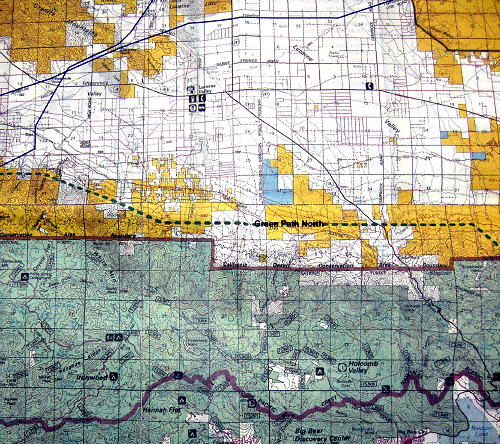An Article In Meteorite-Times Magazine
by Robert Verish
![]()
An Article In Meteorite-Times Magazine
by Robert Verish
Endangered Strewn Fields - the need for Cultural Resource Assessment Studies on Threatened Meteorite Localities
Solar Power Plants that are proposed to be built upon Mojave Desert dry lakes will have an impact on known meteorite strewn fields -- -- Environmental Impact Reports (EIRs) should include Mitigation Options on the impact to "meteoritical resources" just as they do for archeological, geological, and paleontological resources.
Just so there is no misunderstanding, I am all in favor of solar power plants being built in the desert.
I should say, MORE solar power plants, because there are already a number of solar and solar-thermal power plants in the Mojave Desert.
Several of these plants are actually near, or even next to, large playas (also known as, dry lakes).
But until now, NONE of these solar power plants have been built directly on a dry lake!
There are so many issues being raised about these latest solar power projects that the Bureau of Land Management (BLM) had to put a "freeze" on their progress in order to take the proper time to review these requests. But for the purpose of the subject of this article, I want to focus on just the question of "Why do these plants have to be built on dry lakes?"
In particular, why does Lucerne Dry Lake make for a better surface to place ~2000 solar panels than any other barren valley in the Mojave Desert? Especially, since this location is so close to communities and is already an active recreational area, why weren't the local government officials and other stakeholders involved in this decision?
This would be a good point to place a link to the Environmental Impact Report (EIR) that conducted the Assessment Study on these "proposed" dry lake locations, but I still haven't found any reports.
Also, this would be a good point to place a link to an engineering study that addresses the feasibility of constructing solar towers on the surface of an intermittent lake that is actively subsiding, but I still haven't found any such study.
It probably doesn't matter, because they've already surveyed Lucerne Dry Lake for the start of construction!
Before going any farther, it should be explained that there are several types of solar power generation plants:
1. Solar -- utilizing photo-voltaic PANELS, and
2. Solar-Thermal -- of which there are at least 4 main types -- the plant located at Yermo uses thousands of individual sun-tracking mirrors (called heliostats) to reflect solar energy onto a central receiver located on top of a tall tower. The receiver collects the sun's heat in a heat-transfer fluid that flows through the receiver. This heated fluid drives a steam turbine which produces electrical power in a separate generator building.

Based upon the limited information that is currently available, it is my understanding that SOLAR PANELS are intended to be installed at Lucerne Dry Lake, and that solar-thermal plants are to be constructed at Broadwell Dry Lake and Ivanpah Dry Lake.
Here is the link to the news item announcing that a solar (panel) power plant is proposed to be built on Lucerne Dry Lake: Solar Power Plant Proposed in Lucerne Valley
But unlike the array of solar panels that are depicted in the image at the top of this page (which is on a military base in Las Vegas, NV) the solar panels that are planned for Lucerne Dry Lake will be on a 300 foot tower! As I've already mentioned, there have been a number of questions raised about the wisdom of this design being placed on a dry lake, for instance:
How will you contend with flooding? Afterall, it IS an intermittant LAKE, isn't it?
How will you contend with all of the dust from the dry lake coating the panels?
Why be in the bottom of a flat valley? Wouldn't the top of a sloping alluvial fan afford better efficiency at low sun-angles?
In fact, if you're going to use "solar panels", why is the desert a better location?
Unlike "solar-THERMAL plants" where the hotter the environment the better, a desert isn't the ideal place for a solar photo-voltaic system, because its efficiency goes down with higher ambient temperature. it's for this reason that critics of "solar panels in the desert" contend that placing them on roof-tops in industial parks is more cost effective.
But I just want to focus on the main issue of "why does the proposed solar power plant have to destroy a dry lake" like the one in Lucerne Valley. Admittedly there are fewer plants and animals living on a dry lake, but Lucerne Dry Lake, for example, is a unique cultural resource. Lucerne Dry Lake is a historical and a geological-meteoritical resource. This locality is known world-wide for its Lucerne Valley Meteorites. It is a well-documented,and on-going meteorite-recovery study area with a unique meteorite accumulation surface, comprising multiple overlapping strewn fields.
Why is it just assumed that a dry lake is better spot for a solar power plant than, for instance, an alluvial fan, or a mesa?
Where are the Environmental Impact Reports (EIRs) for this proposed project?
Why haven't we had town-hall meetings where the public can review these plans and state our concerns about the pending loss of these resources?

A link to an image of another artist's rendition of a proposed solar-THERMAL power plant near Barstow California, but this time, depicted in a "green field" on private property, and not on a dry lake on public land:

So where do we go to get answers to all of these questions?
While doing a Google search on these topics I discovered there are a number of websites and blogs that deal with the subject of "unchecked industrial and residential development", military base expansions, as well as "intrusive power lines" and other utility company constructions. These websites serve as common points where people can learn of the latest developments and of upcoming meetings. Any one of these websites and blogs would serve as a good template for a discussion group or blog to introduce the issues I have with these proposed power plants on dry lakes.
So, after several people asked me to let them know whenever the BLM will schedule (if ever) a meeting for public comment on these proposed plants, I decided to start one of those discussion groups where these concerns could be voiced, and where a calendar of events and meetings could be announced.
Here is the link to that discussion group:
Without giving it much thought, I gave it the title: Save_Our_Drylakes · Endangered Meteorites!
And here is the text of the "Description" for this new group:
"The encroachment of civilization into the Mojave Desert has an impact on its environment, and its archeological, geological, and paleontological resources. Now add to this list the loss of meteoritical resources (the destruction of meteorite strewn fields and stranding surfaces).
In general this is a Group for exploring methods to mitigate the destruction of meteorite-recovery localities, and the remediation of known meteorite accumulation surfaces and strewn fields.
Specifically, this is a discussion group for finding a way to stop a proposed Solar Power Plant from being constructed directly on Lucerne Dry Lake, and to have it relocated elsewhere. Lucerne Valley Meteorites are a historical and meteoritical resource. This locality is a well-documented, on-going meteorite-recovery study area with a unique meteorite accumulation surface, comprising multiple overlapping strewn fields."
Visit our new Discussion Group at:
Save Our Drylakes
In the above "Description" it is apparent that I used a number of expressions that could be considered as "environmental terms". That's because well before the proposed plan to destroy Lucerne Dry Lake became the tipping point for the formation of this new Discussion Group, the topic of this article has been a subject that I have been long considering.
And that topic is: "Mitigation of Endangered Meteorite Localities"
which is environmental parlance for: "Pay me to look for the meteorites before you build on this site."
Because, after these power plants are finally constructed, there will still be other areas (with meteoritical resource potential) that will come under pressure to be developed. What needs to be in place is a regulatory process that will always ask the proper questions before a development project proceeds. (In this case, the question to be asked is, "Will there be any impact on a known meteorite locality or strewn field?")
Well, there already is a regulatory process in place, and it is called an Environmental Impact Study which is a report better known as an "EIR".
An EIR uses Cultural Resource Assessment reports that are typically prepared by contractors who are licensed/qualified experts, as well as, other published documents. These contractors are experts in the fields of archeological and paleontological sciences, but could just as well include the meteoritical sciences. This section usually discusses cultural resources that would occur on a proposed project site that could be affected by the project, evaluates potential project impacts on these resources, and provides mitigation measures to avoid or reduce those impacts. As part of a Cultural Resources Assessment, there is an Initial Study that is prepared by the contracted experts for a project. These "Initial Studies" determine whether any historic structures are located on the project site, and whether any known Native American cultural values are associated with the project site.
This "Initial Study" also determines whether there are any geological formations that could contain
paleontological resources that could be impacted. This "Initial Study" would be the most logical
point in the EIR process to determine whether there could be an impact to meteoritical resources.
This same study could determine whether any geological surfaces are conducive for preserving
meteorites, as well as report on whether any previous meteorite falls or finds or impacts have been
catalogued from this project area.
Therefore, the "Initial Study" addresses "archeological and paleontological resources" but
could just as easily address meteoritical resources.
To show how easily meteorite localities can be incorporated into the EIR process, I've taken an actual report and edited it for "meteoritical resources". Take a look at my version of a Cultural Resources Report and you will see that a process can be put in place to protect our ever increasingly endangered meteorites.
Residential development, particularly in desert communities like Las Vegas and Phoenix, may be obliterating unknown numbers of meteorite strewn fields.
REFERENCES:
Solar - Thermal Power on Wikipedia:
Solar power plants in the Mojave Desert
Search results on Google for:
"Solar Power Plant Proposed Lucerne Dry Lake"
Search results on Google for:
"Solar Power Plant Mojave Desert"
Link to homepage for:
Lucerne Valley Economic Development Association (LVEDA)
Link to news blog with 3 COMMENTS for:
Solar power panels at Nellis Air Base, Las Vegas, Nevada
Article about proposed Solar-Thermal Power Plant Coming To California Mojave Desert:
11 Responses to “World’s Largest Solar Power Plant Coming To CA Mojave Desert”
Related article about proposed Solar-Thermal Power Plant in Arizona:
33 Responses to “World’s Largest Solar Power Plant Coming to Arizona in 2011”
Article about proposed Solar-Thermal Power Plant in Arizona:
World's Largest Solar Plant in AZ Hinges on US Congress
Article from Reuters about "U.S. solar energy industry blasts government move [to freeze projects]":
BLM says needs time to review requests
Link to the website with the latest issue of:
Desert Report:

Links to website for The Morongo Basin Conservation Association regarding:
The energy industrialization of the Mojave is an environmental justice issue, and
LAND USE DEVELOPMENT ISSUES, and their excellent
BLOGSPOT which is related to SOLAR ENERGY development in the Mojave Desert.
Link to website for:
California Desert Coalition (CDC): Stop LADWP Green Path North
Link to webpage for Stop Green Path with MAPS for the Lucerne Valley power lines:

Link to webpage for Stop The Green Path North Project with many additional links:
For for more information, please contact me by email:
Bolide*chaser
